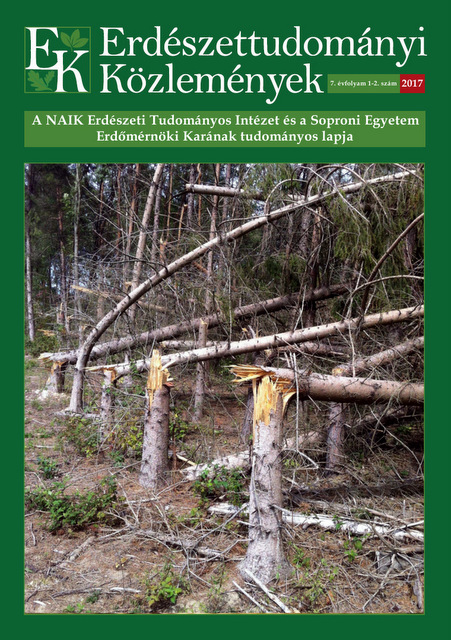| 1. | Ahlén I. 1981: Identification of Scandinavian Bats by their sounds. The Swedish University of Agricultural Sciences, Department of Wildlife Ecology, Uppsala. |
| 2. | Ahlén I. & Baagoe H.J. 1999: Use of ultrasound detectors for bat studies in Europe: experiences from field identification surveys, and monitoring. Acta Chiropterologica 1(2): 137–150. |
| 3. | Barataud M. 2015: Acoustic ecology of European bats. Biotope & National Museum of Natural History, Paris. |
| 4. | Bölöni J. & Ódor P. 2014: A holtfa mennyisége a mérsékelt övi erdőkben. In: Csóka Gy. & Lakatos F. (szerk.): A holtfa. Silva Naturalis 5, Nyugat-magyarországi Egyetem Kiadó, Sopron, 203–217. |
| 5. | Csóka Gy. 2013: A természetesség hatása az erdők egészségi állapotára. In: Bartha D. & Puskás L. (szerk.): Silva Naturalis 1. A folyamatos erdőborítás fenntartása melletti erdőgazdálkodás alapjai. Nyugat-magyarországi Egyetem Kiadó, Sopron, 43–57. |
| 6. | Csősz I. & Szodoray-Parádi F. 2009: Időnyújtásos ultrahang-detektorok alkalmazása a magyarországi denevérfaunisztikai kutatásokban. In: Görföl T., Estók P. & Molnár V. (szerk.): A VII. Magyar Denevérvédelmi Konferencia kiadványa. BEKE & MDBK, Eger, 15-18. |
| 7. | Dietz C. & Kiefer A. 2014: Die Fledermäuse Europas - kennen, bestimmen, schützen. Kosmos Naturführer, Stuttgart. |
| 8. | Entwistle A. C., Racey P.A. & Speakman J.R. 1996: Habitat exploitation by a gleaning bat, Plecotus auritus. Phil. Trans. R. Soc. Lond. B 351(1342): 921–931. DOI: 10.1098/rstb.1996.0085 |
| 9. | Estók P. & Görföl T. 2009: Erdőlakó denevér együttesek kutatása, különös tekintettel a Nyctalus lasiopterusra – egy 2009-es EUROBATS projekt előzetes eredményei. In: Görföl T., Estók P. & Molnár V. (szerk.): A VII. Magyar Denevérvédelmi Konferencia kiadványa. BEKE & MDBK, Eger, 53–60. |
| 10. | Fenton M.B. & Bell G.P. 1981: Recognition of species of insectivorous bats by their echolocation calls. Journal of Mammalogy 62(2): 233–243. DOI: 10.2307/1380701 |
| 11. | Frank T. (szerk.) 2000: Természet – Erdő – Gazdálkodás. MME & Pro Silva Hungaria Egyesület, Eger. |
| 12. | Griffin D.R., Webster F.A. & Michael C.R. 1960: The echolocation of flying insects by bats. Animal Behaviour 8(3-4): 141–154. DOI: 10.1016/0003-3472(60)90022-1 |
| 13. | Jensen M.E. & Miller L.A. 1999: Echolocation signals of the bat Eptesicus serotinus recorded using a vertical microphone array: effect of flight altitude on searching signals. Behavioral Ecology and Sociobiology 47(1-2): 60–69. DOI: 10.1007/s002650050650 |
| 14. | Jones G. 1995: Flight performance, echolocation and foraging behavior in noctule bats Nyctalus noctula. Journal of Zoology 237(2): 303–312. DOI: 10.1111/j.1469-7998.1995.tb02764.x |
| 15. | Jones G. 1996: Does echolocation constrain the evolution of body size in bats? Symposia of the Zoological Society of London 69: 111–128. |
| 16. | Jones G. 1999: Scaling of echolocation call parameters in bats. The Journal of Experimental Biology 202: 3359–3367. |
| 17. | Jones G. & Barratt E.M. 1999: Vespertilio pipistrellus Schreber, 1774 and V. pygmaeus Leach, 1825 (currently Pipistrellus pipistrellus and P. pygmaeus; Mammalia, Chiroptera): proposed designation of neotypes. Bulletin of Zoological Nomenclature 56: 182–186. DOI: 10.5962/bhl.part.23065 |
| 18. | Kalko E.K.V. & Schnitzler H.U. 1989: The echolocation and hunting behavior of Daubenton’s bat, Myotis daubentonii. Behavioral Ecology and Sociobiology 24(4): 225–238. DOI: 10.1007/BF00295202 |
| 19. | Magura T., Tóthmérész B. & Bordán Zs. 2000: Effects of nature management practice on carabid assemblages (Coleoptera: Carabidae) in a non-native plantation. Biological Conservation 93(1): 95–102. DOI: 10.1016/S0006-3207(99)00073-7 |
| 20. | Obrist M., Boesch R. & Flückiger P.F. 2004: Variability in echolocation call design of 26 Swiss bat species: consequences, limits and options for automated field identification with a synergetic pattern recognition approach. Mammalia 68(4): 307–322. DOI: 10.1515/mamm.2004.030 |
| 21. | Ódor P. 2014: A korhadó faanyag szerepe az erdei növények biodiverzitásában. In: Csóka Gy. & Lakatos F. (szerk.): A holtfa. Silva Naturalis 5, Nyugat-magyarországi Egyetem Kiadó, Sopron, 155–170. |
| 22. | Russo D. & Jones G. 2002: Identification of twenty-two bat species (Mammalia: Chiroptera) from Italy by analysis of time-expanded recordings of echolocation calls. Journal of Zoology 258(1): 91–103. DOI: 10.1017/S0952836902001231 |
| 23. | Szőke K. & Estók P. 2013: Különböző állapotú erdőrészek denevéregyütteseinek összehasonlítása akusztikus mintavételek alapján. In: Bíró M. (szerk): A XXX. Országos Tudományos Diákköri Konferencia díjazott hallgatóinak dolgozatai. Eger: EKF Líceum Kiadó, 880–895. |
| 24. | Vaughan N., Jones G. & Harris S. 1997: Identification of British bat species by multivariate analysis of echolocation parameters. Bioacoustics 7(3): 189–207. DOI: 10.1080/09524622.1997.9753331 |
| 25. | Waters D. A. & Jones G. 1995: Echolocation call structure and intensity in five species of insectivorous bats. Journal of Experimental Biology 198: 475–489. |
| 26. | Waters D.A., Rydell J. & Jones G. 1995: Echolocation call design and limits on prey size – a case-study using the aerial hawking bat Nyctalus leisleri. Behavioral Ecology and Sociobiology. 37(5): 321–328. DOI: 10.1007/bf00174136 |
| 27. | Zsebők S. 2003: Impulzusszámlálás, zajszintkezelés, digitális hangfeldolgozás. In: Molnár V., Orbán É. & Molnár Z. (szerk.): A II. Magyar Denevérvédelmi Konferencia (Szabadkígyós, 1999. december 4.), a III. Magyar Denevérvédelmi Konferencia (Tokaj, 2001. december 1.) és a IV. Magyar Denevérvédelmi Konferencia (Szögliget, 2003. november 22-23.) kiadványa, Magyar Denevérkutatók Baráti Köre, Budapest, 140–146. |
| 28. | Zsebők S., Estók P. & Görföl, T. 2012: Acoustic discrimination of Pipistrellus kuhlii and Pipistrellus nathusii (Chiroptera: Vespertilionidae) and its application to assess changes in species distribution. Acta Zoologica Academiae Scientiarum Hungaricae 58(2): 199–209. |
